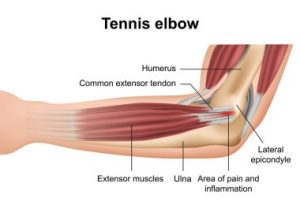
How To Work Out With Tennis Elbow (9 Helpful Guidelines)
How to Work Out with Tennis Elbow: Focus on low-impact exercises that strengthen surrounding muscles without exacerbating inflammation. Tennis elbow: the bane of many athletes, fitness enthusiasts, and even those who never stepped onto a tennis court. Despite its name, this pesky condition doesn’t discriminate, haunting the determined souls striving for peak physical prowess.
But fear not, for in the realm of fitness, adversity breeds innovation. So, if you’re nodding in painful solidarity or preemptively wincing at the mere thought of gripping a weight, fret not! Let’s embark on a journey of discovery, exploring the intricate dance of healing and exercise, revealing the secrets of how to defy tennis elbow and emerge stronger than ever before. It’s time to lace up your metaphorical sneakers, flex those mental muscles, and let’s dive into the art of working out with tennis elbow!

How To Work Out With Tennis Elbow
Tennis elbow, medically known as lateral epicondylitis, can be challenging to manage during workouts. However, with proper techniques and modifications, you can still maintain your fitness routine while managing the pain and discomfort associated with this condition.
Understanding Tennis Elbow:
Tennis elbow, characterized by pain and inflammation on the outer part of the elbow, often occurs due to overuse or repetitive strain. Despite its name, it can affect anyone, not just tennis players. It commonly arises from activities involving gripping, lifting, or repetitive arm movements.
Modifying Your Workouts:
To continue exercising with tennis elbow, focus on low-impact activities that don’t aggravate the condition. Opt for exercises that minimize stress on the affected tendon, such as swimming, cycling, or using an elliptical machine. Avoid movements that involve gripping tightly or twisting the wrist, as these can exacerbate symptoms.
Strengthening and Stretching:
Incorporate exercises that strengthen the muscles surrounding the elbow and forearm to provide better support and stability. Gentle stretching can also help improve flexibility and reduce stiffness. However, it’s crucial to start slowly and gradually increase intensity to avoid further strain.
Using Proper Equipment and Techniques:
Ensure that you’re using proper equipment and techniques during your workouts. Use lighter weights and thicker grips to reduce strain on the tendons. Additionally, consider using braces or straps to provide support and alleviate pressure on the affected area.
Listening to Your Body:
Pay attention to your body’s signals and avoid pushing through pain. If an exercise causes discomfort, modify it or try alternative movements. Rest is also essential for recovery, so be sure to incorporate rest days into your workout routine to allow your muscles and tendons to heal.
Seeking Professional Guidance:
Consult with a healthcare professional or physical therapist for personalized advice and guidance on managing tennis elbow. They can recommend specific exercises, techniques, and treatments tailored to your condition to help alleviate symptoms and prevent further injury.
Understanding Tennis Elbow
Definition and causes of Tennis Elbow:
Tennis elbow, medically known as lateral epicondylitis is a painful condition affecting the tendons in the elbow. It commonly occurs due to repetitive gripping and wrist movements, often associated with sports like tennis and activities involving manual labor. Overuse of the forearm muscles, poor technique, and sudden increases in activity levels are common triggers for this condition.
Symptoms and diagnosis of Tennis Elbow:
Symptoms of tennis elbow include pain and tenderness on the outer part of the elbow, which may radiate down the forearm. Gripping objects or twisting motions can exacerbate the pain. Diagnosis often involves a physical examination by a healthcare professional, focusing on the specific location of the pain and assessing the range of motion in the elbow joint. Imaging tests such as X-rays or MRI scans may be used to rule out other possible causes of the symptoms.
Importance of rest and rehabilitation for Tennis Elbow:
Rest is crucial in the early stages of tennis elbow to allow the inflamed tendons to heal. Avoiding activities that exacerbate the pain and applying ice packs can help reduce inflammation. Rehabilitation often involves stretching and strengthening exercises to improve flexibility and muscle strength in the forearm and wrist. Additionally, techniques such as massage and physical therapy may be beneficial in relieving symptoms and preventing recurrence. Consistent adherence to a rehabilitation program is key to fully recovering from tennis elbow and preventing future episodes.

Pre-Workout Considerations
Consultation with a healthcare provider:
Before diving into any pre-workout routine, it’s crucial to consult with a healthcare provider to ensure it aligns with your health status and goals. This step involves discussing any underlying medical conditions, medications, or potential risks. Seeking professional guidance can prevent injury and optimize your workout experience.
Assessing pain levels and limitations:
Understanding your pain levels and physical limitations is essential for crafting an effective pre-workout plan. Take note of any discomfort or restricted movement areas in your body. This assessment allows for tailoring exercises to accommodate individual needs and avoid exacerbating existing issues.
Modification of exercises and activities:
Flexibility in modifying exercises and activities is key to a sustainable and productive pre-workout routine. Adjustments can be made based on fitness level, injuries, or personal preferences. Whether it’s reducing intensity, altering movements, or exploring alternative exercises, customization enhances safety and effectiveness.
Warm-Up Routine
Importance of warming up muscles and tendons:
Warming up muscles and tendons before engaging in physical activity is paramount for optimizing performance and preventing injuries. The importance lies in the physiological benefits it offers to the body. A proper warm-up routine increases blood flow to the muscles, enhancing their flexibility and elasticity. This, in turn, improves the range of motion in joints and reduces the risk of strains or tears.
Additionally, warming up activates the nervous system, allowing for better coordination and reaction times during exercise. It also prepares the cardiovascular system by gradually increasing heart rate and respiratory rate, ensuring that the body is ready for the demands of the upcoming activity. In essence, dedicating time to warming up sets the stage for a safer, more effective workout or sports performance.
Gentle stretching exercises for the forearm, wrist, and elbow:
Gentle stretching exercises for the forearm, wrist, and elbow are essential for maintaining flexibility, preventing injuries, and alleviating discomfort associated with repetitive strain or overuse. These exercises target the muscles and tendons in the arms, promoting improved circulation and range of motion. Simple wrist flexion and extension movements, where you gently bend your wrist forward and backward, can help release tension and increase flexibility.
Additionally, forearm stretches such as the wrist flexor and extensor stretches can be beneficial. To stretch the elbow, gentle movements like the forearm pronation and supination stretch can help alleviate stiffness and improve mobility. It’s crucial to perform these stretches slowly and without force, holding each stretch for about 15-30 seconds and repeating them a few times throughout the day to promote optimal muscle health and flexibility. Regular practice of these gentle stretching exercises can contribute to overall arm wellness and reduce the risk of strain or injury.

Low-impact cardiovascular warm-up to increase blood flow:
Engaging in low-impact cardiovascular exercises like brisk walking or cycling boosts blood circulation, delivering oxygen and nutrients to muscles. This type of warm-up enhances cardiovascular endurance and primes the body for more intense physical activity. Incorporating a cardiovascular warm-up session before workouts can enhance overall performance and reduce the risk of cardiovascular issues.
Choosing Appropriate Exercises
Avoidance of high-impact and high-intensity exercises:
When dealing with tennis elbow, it’s crucial to approach workouts with caution, avoiding high-impact and high-intensity exercises that could exacerbate the condition. Instead, focusing on gentle and controlled movements can help to strengthen the muscles surrounding the elbow while minimizing strain. Opting for exercises that target flexibility, such as gentle stretching and range-of-motion exercises, can aid in maintaining mobility without putting excessive stress on the affected area. Additionally, incorporating exercises that strengthen the forearm muscles gradually and with proper form can promote healing and prevent further injury.
Focus on strengthening exercises that target surrounding muscles:
Emphasize strengthening exercises to fortify the muscles supporting the affected area. Engage in forearm exercises like wrist curls and extensions to enhance stability. Boost grip strength with exercises such as grip squeezes and hand grips. Incorporate shoulder and upper back exercises to reinforce posture and alleviate strain.
Incorporation of flexibility and mobility exercises:
Integrate flexibility and mobility exercises to maintain joint health and range of motion. Stretching routines can aid in loosening tight muscles and improving flexibility. Mobility exercises enhance joint mobility and reduce stiffness. Prioritize exercises that enhance overall flexibility and mobility to alleviate discomfort and improve function.
Examples of suitable exercises for tennis elbow sufferers:
For individuals dealing with tennis elbow, it’s essential to engage in exercises that strengthen the muscles around the forearm while avoiding excessive strain on the affected tendons. One suitable exercise is wrist curls with light dumbbells, performed with palms facing upwards and slowly curling the weight towards the body, then lowering it back down.
Another beneficial exercise is eccentric wrist flexion, which involves using the unaffected hand to assist in lifting a light weight (such as a dumbbell or resistance band) with the affected hand, then slowly lowering it down. Additionally, forearm pronation and supination exercises using a light resistance band can help improve flexibility and strength. It’s crucial to start with low resistance and gradually increase as tolerated, while always maintaining proper form to prevent further injury.

Workout Guidelines
Begin with Gentle Resistance and Few Reps:
It’s crucial to approach workouts with caution and consideration for the injury. Begin with gentle resistance exercises and keep the number of repetitions low to avoid exacerbating the condition. Focus on movements that don’t strain the affected area excessively.
Progressive Intensity Enhancement:
When dealing with tennis elbow, adhering to workout guidelines that focus on progressive intensity enhancement is crucial for effective rehabilitation and prevention of further injury. Begin by incorporating exercises that target strengthening the muscles surrounding the elbow, such as wrist curls, forearm pronation and supination, and gentle gripping exercises using resistance bands or light weights.
Gradually increase the intensity of these exercises over time, ensuring that you listen to your body and avoid any movements that cause pain or discomfort. Incorporating stretching routines to improve flexibility and mobility in the affected area can also aid in recovery. It’s essential to strike a balance between challenging your muscles and allowing them time to rest and recover, as overexertion can exacerbate the condition.
Emphasize Proper Form and Technique:
When dealing with tennis elbow, it’s crucial to approach workouts with caution and prioritize proper form and technique. Workout guidelines for tennis elbow emphasize the importance of gentle, controlled movements that don’t exacerbate the condition. Focus on exercises that strengthen the muscles surrounding the elbow without putting undue stress on the affected area. Avoid movements that involve gripping or twisting, as these can aggravate symptoms. Instead, opt for exercises that promote flexibility and stability, such as wrist curls, forearm stretches, and gentle range of motion exercises.
Listen to Your Body:
Pay close attention to your body’s signals and adjust your workout regimen accordingly, whether it’s by easing off during periods of fatigue or pushing harder when feeling energized.
Rest and Recovery
Importance of rest days in between workouts:
Rest days are crucial for muscle recovery and growth, preventing injury, and optimizing performance. Without adequate rest, muscles can become fatigued, increasing the risk of overuse injuries. Incorporating rest days allows the body to repair and rebuild muscle tissue, leading to strength gains and improved athletic performance.
Incorporation of active recovery techniques:
Incorporating active recovery techniques such as foam rolling and gentle stretching can enhance blood flow, reduce muscle soreness, and improve flexibility. These techniques help to flush out metabolic waste products and reduce inflammation, promoting quicker recovery between workouts.
Application of ice or heat therapy for pain management:
Ice or heat therapy can be applied as needed for pain management and injury treatment. Ice helps to reduce inflammation and numb pain, while heat therapy increases blood flow and relaxes muscles. Alternating between ice and heat can provide effective relief for sore muscles and joints.
Prevention Strategies
Proper technique and equipment use in daily activities:
Utilizing correct techniques and appropriate equipment during daily tasks is essential for preventing repetitive strain injuries. This includes maintaining ergonomic principles such as proper wrist alignment and using supportive tools like wrist rests and ergonomic keyboards. Adhering to these practices minimizes the risk of developing discomfort or pain associated with repetitive movements.
Maintenance of good posture and ergonomics:
Maintaining good posture and ergonomic setups is crucial in preventing strain on the forearm muscles. This involves sitting with the back straight, shoulders relaxed, and arms positioned comfortably. Ergonomic adjustments to workstations, such as adjusting chair height and monitor placement, can greatly alleviate stress on the forearms. Implementing these measures helps in reducing the likelihood of developing repetitive strain injuries.
Regular stretching and strengthening exercises for forearm muscles:
Incorporating regular stretching and strengthening exercises into a daily routine can effectively prevent forearm muscle strain. Exercises like wrist flexion and extension stretches, forearm rotations, and grip strengthening exercises help improve muscle flexibility and endurance. Engaging in these activities regularly aids in reducing tension and increasing resilience in the forearm muscles, thereby lowering the risk of injury.
Avoidance of repetitive movements that exacerbate symptoms:
Avoiding repetitive movements that exacerbate symptoms is paramount in preventing forearm strain. This includes taking breaks from activities that involve continuous wrist or forearm movements and varying tasks to distribute the workload evenly. Being mindful of posture and implementing ergonomic principles further supports the prevention of strain caused by repetitive movements. By minimizing repetitive actions, individuals can safeguard against developing discomfort or pain in the forearms.
Monitoring Progress
Tracking Pain Levels and Symptoms Over Time:
Monitoring progress involves consistently logging pain levels and symptoms to gauge improvement or deterioration. Utilizing pain diaries or symptom trackers helps individuals track their health journey effectively. By recording data regularly, individuals can identify patterns and trends in their condition, aiding healthcare professionals in making informed decisions about treatment adjustments. This meticulous tracking enables patients to communicate their experiences accurately during medical appointments, facilitating collaborative and personalized care plans.
Modification of Workout Routines Based on Progress and Feedback:
Adapting workout routines according to progress and feedback is crucial for achieving fitness goals effectively. Regular assessments of performance and body changes allow for tailored adjustments to exercise plans. Incorporating feedback from trainers or fitness apps ensures workouts remain challenging yet safe. By monitoring progress and making necessary modifications, individuals can prevent plateaus and maximize their fitness potential, fostering continual improvement and motivation.
Celebrating Achievements and Milestones in Recovery and Strength Improvement:
Acknowledging achievements and milestones in recovery and strength improvement is essential for maintaining motivation and morale. Recognizing progress, no matter how small, boosts confidence and encourages perseverance. Whether it’s reaching a weightlifting goal or overcoming a physical challenge, celebrating these victories reinforces positive habits and fosters a sense of accomplishment. Sharing successes with support networks further amplifies the joy and motivation, creating a cycle of encouragement and progress.
Seeking Professional Guidance
Referral to physical therapists or occupational therapists for specialized exercises and treatments:
Seeking professional guidance often involves consulting physical therapists or occupational therapists, who offer tailored exercises and treatments. These experts provide personalized care to address specific needs and conditions. Patients may benefit from rehabilitation programs designed to enhance mobility and improve function. Working closely with these specialists can lead to significant improvements in overall well-being.
Consideration of alternative therapies such as acupuncture or massage:
Exploring professional guidance may also entail considering alternative therapies like acupuncture or massage. Many individuals seek relief from pain and discomfort through these non-conventional methods. Acupuncture, for instance, involves the insertion of thin needles into specific points on the body to alleviate symptoms. Likewise, massage therapy focuses on manipulating soft tissues to promote relaxation and alleviate tension. Integrating these approaches into a comprehensive treatment plan can offer holistic benefits.

Surgical intervention in severe cases resistant to conservative treatments:
In some cases, seeking professional guidance may lead to surgical intervention for conditions resistant to conservative treatments. Despite efforts with non-invasive approaches, certain conditions may persist or worsen. Surgical options are then explored to address underlying issues and improve outcomes. Procedures may vary depending on the specific condition and its severity. Collaboration between patients, physicians, and surgeons ensures informed decisions are made regarding the most appropriate course of action.
Frequently Asked Questions (FAQ) about How To Work Out With Tennis Elbow
Q1. What is tennis elbow, and why is it important to modify workouts?
A. Tennis elbow, or lateral epicondylitis, is a condition characterized by pain and inflammation in the tendons that join the forearm muscles on the outside of the elbow. Modifying workouts is crucial to avoid exacerbating the condition and aiding in its recovery.
Q2. Can I still exercise with tennis elbow?
A. Yes, you can still exercise with tennis elbow, but it’s important to modify your routine to avoid putting excess strain on the affected tendons.
Q3. What exercises should I avoid with tennis elbow?
A. Exercises that involve gripping, twisting, or lifting heavy weights, such as certain types of bicep curls, forearm curls, or wrist curls, should be avoided as they can aggravate tennis elbow.
Q4. What are some safe exercises for tennis elbow?
A. Low-impact exercises that don’t strain the forearm tendons excessively are generally safe, such as gentle stretching, wrist flexor and extensor exercises, and exercises that strengthen the shoulder and upper back muscles.
Q5. How should I warm up before exercising with tennis elbow?
A. Prioritize a thorough warm-up to increase blood flow and flexibility in the muscles and tendons. Light cardiovascular activity like walking or cycling followed by dynamic stretches focusing on the shoulders, wrists, and forearms can be beneficial.
Q6. Should I use braces or straps when working out with tennis elbow?
A. Braces or straps can provide support and alleviate some of the strain on the affected tendons during workouts. Consult with a healthcare professional to determine if they’re suitable for your condition and exercise routine.
Q7. How often should I exercise with tennis elbow?
A. It’s essential to listen to your body and avoid overexertion. Start with shorter, less intense workouts and gradually increase frequency and intensity as your symptoms improve. Consult with a healthcare professional for personalized recommendations.
Q8. Is it okay to continue playing tennis or other racquet sports with tennis elbow?
A. It’s generally recommended to avoid activities that exacerbate symptoms, including tennis or other racquet sports, until the condition improves. Once symptoms subside, gradually reintroduce these activities and consider using proper technique and equipment to prevent recurrence.
Q9. What role does rest play in recovering from tennis elbow?
A. Rest is crucial for allowing the affected tendons to heal. Avoiding activities that worsen symptoms and incorporating periods of rest between workouts is essential for recovery.
Q10. When should I seek medical advice for tennis elbow?
A. If symptoms persist despite rest and modifications to your workout routine, or if you experience severe pain, swelling, or loss of function in the affected arm, it’s important to seek medical advice promptly. A healthcare professional can provide a comprehensive evaluation and recommend appropriate treatment options.
Conclusion
In conclusion, managing and working out with tennis elbow requires a multifaceted approach that prioritizes gradual rehabilitation, proper technique, and strategic exercise selection. By incorporating targeted exercises to strengthen the forearm muscles, improving flexibility, and implementing ergonomic adjustments, individuals can effectively alleviate pain and restore function.
It is crucial to listen to one’s body, avoiding activities that exacerbate symptoms while gradually reintroducing movements as strength and flexibility improve. Additionally, seeking guidance from healthcare professionals, such as physical therapists or sports medicine specialists, can provide personalized treatment plans and ensure safe progression throughout the recovery process. With patience, diligence, and a comprehensive approach, individuals can overcome the challenges of tennis elbow and return to their favorite activities with confidence and resilience.